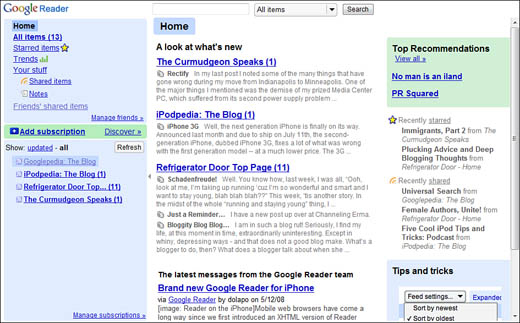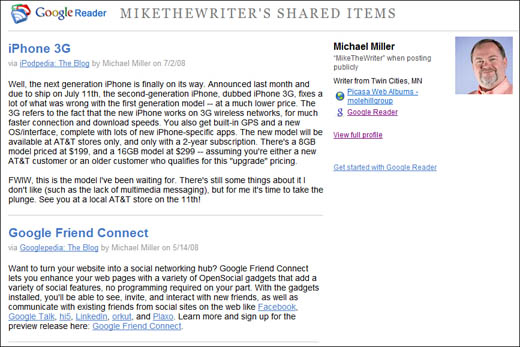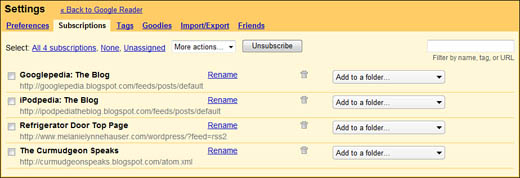You access Google Reader at reader.google.com. Google Reader lets you read both blog feeds and news feeds. That means you can use Google Reader to display the latest news headlines from popular news sites, as well as catch the latest ponderings from your favorite bloggers. All you need to do is know which feed you want to subscribe to; Google Reader automatically displays the latest content, all in one place.
As you can see in Figure 23.1, the blogs you’ve subscribed to are displayed in the left panel. To read the latest postings for a given blog, just click the blog name; the blog postings are displayed in the window on the right, as shown in Figure 23.2. Use the scroll bar or the Previous Item/Next Item buttons to move through the postings.
If you’d prefer to view only the titles of the blog postings, select the List View tab. This displays a list of postings; click any title to expand the listing and read the complete posting.
By the way, if you’d prefer to read a posting on the original blog site itself, rather than in Google Reader, click the title of the blog entry. The selected post on the original blog site opens in a new browser window.
To help categorize your postings, Google lets you add tags. Just click the Add Tags link under any posting, and then enter one or more keywords to describe the posting.
You can also send blog postings to your friends and family via email. Click the Email link under the posting to expand it, and then enter the recipient’s email address, add a personal note, and click the Send button. The blog post is sent to the recipient via your Gmail account.
You’re not limited to sharing individual blog posts via email. Google Reader also lets you create a new feed composed of the individual blog feeds you want to share.
All you have to do is click the Share link under the blog entries you want to share. Then click the Shared Items link in the left panel. The Your Shared Items page displays a link to a web page that contains your shared items; you can email this link to anyone you like. Figure 23.3 shows a typical shared items page; it’s like a blog of your favorite blog postings!
There are several ways to add a blog feed to Google Reader. They’re all relatively easy to do.
You start by clicking the Add Subscription link in the left panel; this displays an Add Subscription box. From here, you can do one of the following:
-
Enter the URL for a blog
-
Enter the URL for a blog’s RSS or Atom feed
-
Enter one or more keywords to search for blogs of a given type
Google Reader returns a list of matching blogs. Click the Subscribe button to add that blog subscription to Google Reader.
Alternatively, you can browse for blogs to subscribe to. When you click the Discover link next to the Add Subscription link, you see the Discover and Search for Feeds page.
From here you can select from Google’s recommended blogs (the Recommendations tab) or click the Browse tab. This tab, shown in Figure 23.4, presents three ways to find blog feeds:
-
Subscribe to a preselected bundle of feeds, based on a particular topic. (Three bundles are shown on the main page; click the More Bundles link to view—well, more bundles.)
-
Subscribe to feeds from friends and family—as long as their blogs are hosted by Blogger, Flickr, or MySpace. Just enter the username, select the blog host service, and click the Subscribe button.
-
Search for blogs by keyword (the same as with the Add Subscription box).
If you’ve already created a list of feed subscriptions in another feed aggregator or feed reader, you can import that list into Google Reader—which definitely beats reentering your feeds by hand. This assumes, of course, that your previous feed reader/aggregator saved its subscription list in industry-standard OMDP format and that you have that file stored on your computer’s hard disk. All that assumed, here’s what you need to do:
-
From the Google Reader home page, click the Settings link.
-
When the Settings page appears, click the Import/Export tab.
-
From the Import/Export tab, click the Browse button to find and select the OMDP file that holds your feed subscriptions.
-
Click the Upload button.
Tip
Google Reader isn’t the only feed aggregator site on the Web. Some popular competing aggregators include Bloglines (www.bloglines.com) and NewsGator (www.newsgator.com). Alternatively, you can read your blog feeds in a freestanding feed-reader software program, such as FeedDemon (www.feeddemon.com).
That does the trick. All the feeds in your old subscription file now appear as subscriptions in Google Reader.
Want to change your subscription list—to delete a feed, or change information about a feed? It’s easy enough to do. Just click the Settings link at the top of the Google Reader home page, and then select the Subscriptions tab. This tab, shown in Figure 23.5, lists all the feeds you’re currently subscribed to.
To delete a feed, all you have to do is click the trash can icon next to the feed name. To rename a feed (perhaps to something more meaningful to you), click the Rename link. To organize your feeds into folders, click the Add to a Folder button and either select an existing folder or create a new one. The tasks are relatively self-explanatory.





